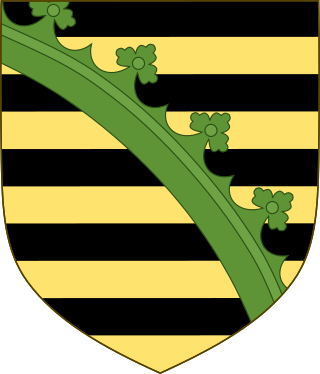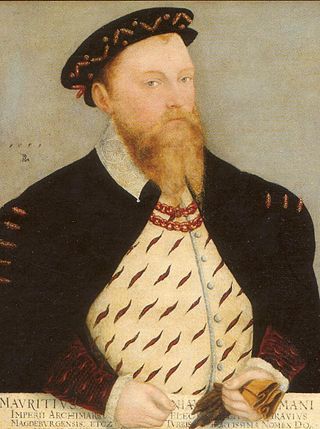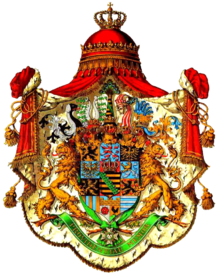
Albert III was a Duke of Saxony. He was nicknamed Albert the Bold or Albert the Courageous and founded the Albertine line of the House of Wettin.

George the Bearded was Duke of Saxony from 1500 to 1539 known for his opposition to the Reformation. While the Ernestine line embraced Lutheranism, the Albertines were reluctant to do so. Despite George's efforts to avoid a succession by a Lutheran upon his death in 1539, he could not prevent it from happening. Under the Act of Settlement of 1499, Lutheran Henry IV became the new duke. Upon his accession, Henry introduced Lutheranism as a state religion in the Albertine lands of Saxony.

The history of Saxony-Anhalt began with Old Saxony, which was conquered by Charlemagne in 804 and transformed into the Duchy of Saxony within the Carolingian Empire. Saxony went on to become one of the so-called stem duchies of the German Kingdom and subsequently the Holy Roman Empire which formed out of the eastern partition of the Carolingian Empire. The duchy grew to become a powerful state within the empire, ruling over much of what is now northern Germany, but following conflicts with the emperor it was partitioned into numerous minor states, including the Principality of Anhalt, around the end of the 12th century and early 13th century. The territories of the Duchy of Saxony, the Principality of Anhalt, and their successors are now part of the modern German state of Saxony-Anhalt.

The House of Wettin was a dynasty of German kings, prince-electors, dukes, and counts that once ruled territories in the present-day German states of Saxony, Saxony-Anhalt and Thuringia. The dynasty is one of the oldest in Europe, and its origins can be traced back to the town of Wettin, Saxony-Anhalt. The Wettins gradually rose to power within the Holy Roman Empire. Members of the family became the rulers of several medieval states, starting with the Saxon Eastern March in 1030. Other states they gained were Meissen in 1089, Thuringia in 1263, and Saxony in 1423. These areas cover large parts of Central Germany as a cultural area of Germany.

Saxe-Coburg was a duchy held by the Ernestine branch of the Wettin dynasty in today's Bavaria, Germany.

The Capitulation of Wittenberg was a treaty on 19 May 1547 by which John Frederick I, Elector of Saxony, was compelled to resign the title of elector. The Electorate of Saxony and most of his territory, including Wittenberg, passed from the elder Ernestine line to the cadet Albertine line of the House of Wettin.

Saalfeld is a town in Germany, capital of the Saalfeld-Rudolstadt district of Thuringia. It is best known internationally as the ancestral seat of the Saxe-Coburg and Gotha branch of the Saxon House of Wettin.

Maurice was Duke (1541–47) and later Elector (1547–53) of Saxony. His clever manipulation of alliances and disputes gained the Albertine branch of the Wettin dynasty extensive lands and the electoral dignity.

Saxe-Weimar was one of the Saxon duchies held by the Ernestine branch of the Wettin dynasty in present-day Thuringia. The chief town and capital was Weimar. The Weimar branch was the most genealogically senior extant branch of the House of Wettin.

Saxe-Eisenach was an Ernestine duchy ruled by the Saxon House of Wettin. The state intermittently existed at three different times in the Thuringian region of the Holy Roman Empire. The chief town and capital of all three duchies was Eisenach.

The Ernestine duchies, also known as the Saxon duchies, were a group of small states whose number varied, which were largely located in the present-day German state of Thuringia and governed by dukes of the Ernestine line of the House of Wettin.

Augustus was Elector of Saxony from 1553 to 1586.

The Electorate of Saxony, also known as Electoral Saxony, was a territory of the Holy Roman Empire from 1356–1806. Its territory included the areas around the cities of Dresden, Leipzig and Chemnitz.

The Treaty of Leipzig or Partition of Leipzig was signed on 11 November 1485 between Elector Ernest of Saxony and his younger brother Albert III, the sons of Elector Frederick II of Saxony from the House of Wettin. The agreement perpetuated the division of the Wettin lands into a Saxon and a Thuringian part, which in the long run obstructed the further development of a Central German hegemonic power in favour of Brandenburg-Prussia.

The Division of Altenburg was the plan for the division of the Meissen lands agreed upon by the two hostile Wettin brothers Elector Frederick II of Saxony and William III on 16 July 1445 at Altenburg. The brothers had attempted to reconcile, but eventually the division led the Saxon Fratricidal War, which began in 1446 and lasted for five years, until the Peace of Naumburg was negotiated in 1451. Following the peace, the subsequent Treaty of Eger in 1459, and the deaths of Frederick II and William III, the two sons of Frederick II eventually gained control of the land of both their father and William III.

The Duchy of Żagań or Duchy of Sagan was one of the duchies of Silesia ruled by the Silesian Piasts. Its capital was Żagań in Lower Silesia, the territory stretched to the town of Nowogród Bobrzański in the north and reached the Lusatian Neisse at Przewóz in the west, including two villages beyond the river.

Johanna Magdalena of Saxe-Altenburg was a member of the House of Wettin. She was a Duchess of Saxe-Altenburg by birth and by marriage a Duchess of Saxe-Weissenfels-Querfurt.

Princely count William IV of Henneberg-Schleusingen, a member of the House of Henneberg, was a ruler of the Principality of Henneberg, within the Holy Roman Empire.
The “Grumbach Feud”, in 1567, was a rather bizarre episode in the history of the Ernestine side of the House of Wettin, which led to life imprisonment for Elector John Frederick II “the Middle”, the Duke of Saxe-Coburg-Eisenach.

The history of Saxon coinage or Meissen-Saxon coinage comprises three major periods: the high medieval regional pfennig period, the late medieval pfennig period and the thaler period, which ended with the introduction of the mark in 1871/72. Rich silver deposits, which were discovered near Freiberg after the middle of the 12th century, helped Saxony to a leading position in German coinage.




















